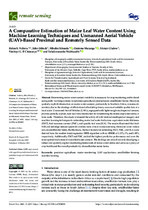| dc.description.abstract | : Determining maize water content variability is necessary for crop monitoring and in developing early warning systems to optimise agricultural production in smallholder farms. However,
spatially explicit information on maize water content, particularly in Southern Africa, remains elementary due to the shortage of efficient and affordable primary sources of suitable spatial data at a
local scale. Unmanned Aerial Vehicles (UAVs), equipped with light-weight multispectral sensors,
provide spatially explicit, near-real-time information for determining the maize crop water status at
farm scale. Therefore, this study evaluated the utility of UAV-derived multispectral imagery and
machine learning techniques in estimating maize leaf water indicators: equivalent water thickness
(EWT), fuel moisture content (FMC), and specific leaf area (SLA). The results illustrated that both
NIR and red-edge derived spectral variables were critical in characterising the maize water indicators on smallholder farms. Furthermore, the best models for estimating EWT, FMC, and SLA were
derived from the random forest regression (RFR) algorithm with an rRMSE of 3.13%, 1%, and 3.48%,
respectively. Additionally, EWT and FMC yielded the highest predictive performance and were the
most optimal indicators of maize leaf water content. The findings are critical towards developing a
robust and spatially explicit monitoring framework of maize water status and serve as a proxy of
crop health and the overall productivity of smallholder maize farms. | en_US |

